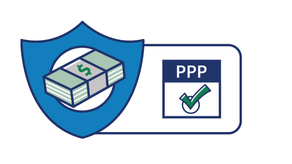The big rush to get in line for limited PPP funds ended two weeks after it began. Many small businesses were left waiting and wondering if they had been approved and if they would receive funding. Many are still waiting and hoping the program receives additional funding (looks promising as of 4/21/20). But you are one of the lucky ones. The dollars hit your bank account. Congratulations are in order!
Take a minute and celebrate. Somehow you navigated a loan process that included an application that changed more than once, and that, believe it or not was the easy part! You managed your way through vague definitions and ever-changing rules on what should be included and excluded in the loan calculator. You still don’t fully understand the complex forgiveness rules, but that can be dealt with later. Ok, your minute is up. Do you hear the clock ticking? It is, it’s time to get to work.
It’s time to address the overly complex forgiveness provisions of the CARES Act. 100% forgiveness is going to take some work and you may end up needing to be creative to make it happen. This post is to help those that want to pursue 100% (or as close to it as possible) forgiveness.
I mentioned your clock is ticking. You had 8-weeks from the day your loan originated to spend the loan proceeds. A couple things that are clear as it relates to the PPP is this 8-week window and the fact you have to spend at least 75% of the proceeds on payroll to achieve full forgiveness. So far so good, right? This doesn’t seem too complex.
I’ve spoken to countless business owners that are struggling with the idea that their clock has started even though their business isn’t close to reopening. Many are concerned they won’t be open if at the end of the 8-week period. The PPP was designed to help businesses retain employees for about two months, even if there was no work to be done. Business owners are in a position to throw out all logic and business sense solely in an attempt to avoid being saddled with a loan with unfavorable terms (for many small businesses we work with).
Let’s keep this really simple. If you want to achieve 100% forgiveness, you need to start paying your people NOW. You should get your payrolls running again. Make sure you are paying your employees a wage (all-in) that is close to or exactly what their average compensation was previously. Doing so will help you spend the proceeds based on the intent of the law and get your close to maxing out your forgiveness.
Depending on how you calculated your loan, you may need to get creative as you approach the end of the 8-week period. If your loan included employer FICA taxes or 1099 contractors, you received more money than you are spending in your standard payroll (only gross wages count for forgiveness and 1099 contractors do not). You may need to look at running a special payroll near the end of the period to ensure you spend all loan proceeds and hit the 75% spend on payroll.
The provisions of the program lack clarity and we can only guess at what the final forgiveness provisions will be. We need clarity on the definition of a full time equivalent employee (FTEE). There are more questions than I can count related to the salary and wage reduction calculation.
Focus on what you can control. You know you have to spend the loan proceeds in 8-weeks. You also know that 75% has to be spent on payroll and the remaining amounts can be spent on your lease, utilities and mortgage interest. Take care of the cash outflow side of the equation. As we get more guidance we can flip our attention to forgiveness calculations as it relates to headcount and wages paid per employee.
The intent of the law was to keep employees on payroll. I strongly encourage you to do what you can to ensure your business at the end of the 8-week period looks the same as it did pre-virus (~February 15, 2020). Following this suggestion is the safest approach you can take to achieve 100% forgiveness.
We will stay on top of any guidance put out related to the penalty provisions. Check out our resource center and facebook for updates as they happen.




